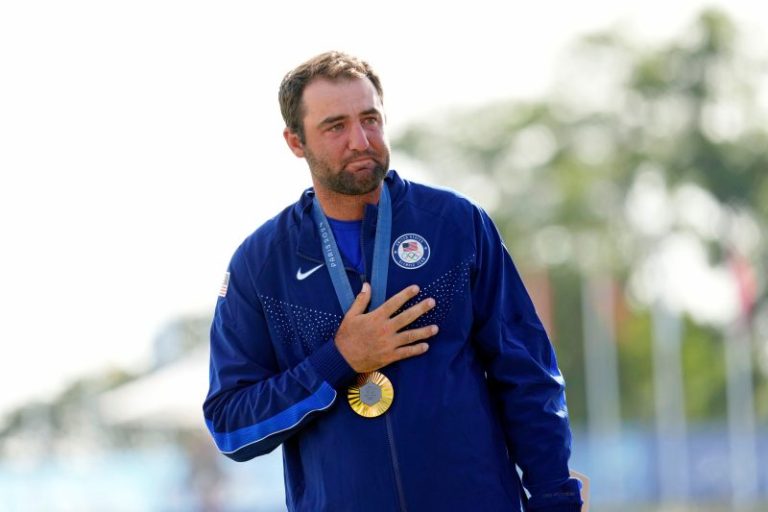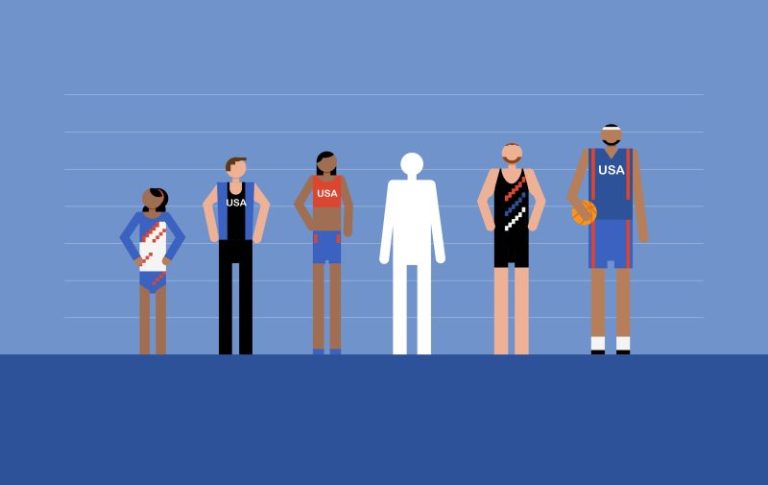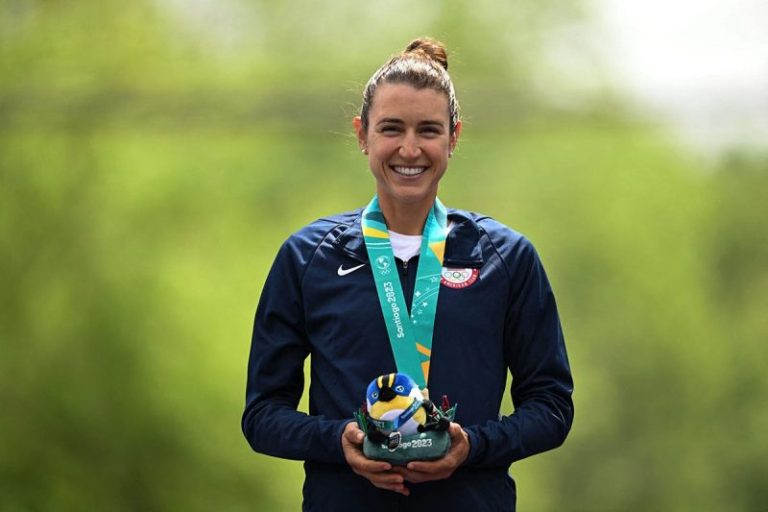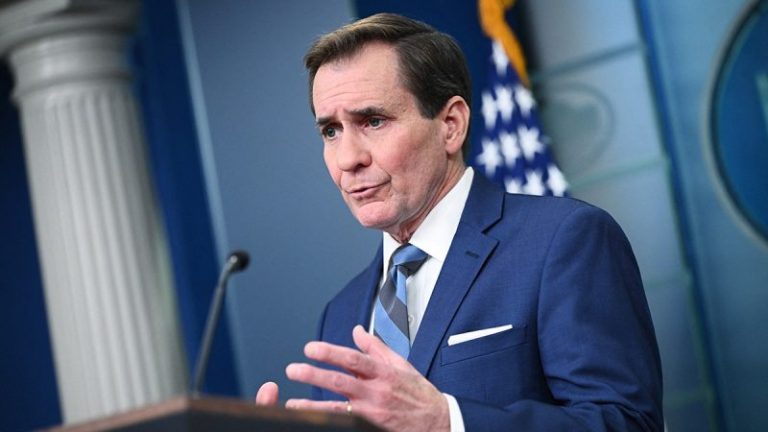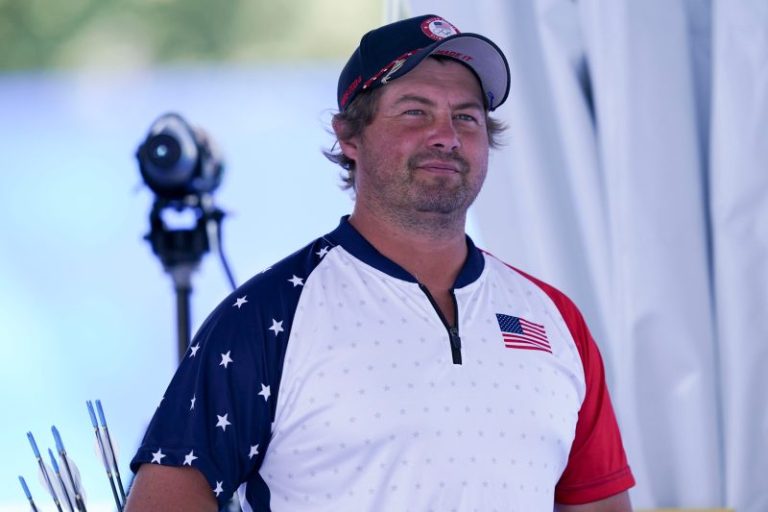Team USA women’s basketball was intent on keeping the good times rolling at the 2024 Paris Olympics on Sunday as the team concluded group-stage play undefeated with a win over Germany.
The clash determined the winner of Group C, with both teams entering the game unbeaten. Both teams had assured themselves of a place in the quarterfinal round, but the U.S. will now receive a theoretically easier assignment ahead of knockout play as the group winner.
Team USA started its quest for an eighth straight gold medal with a 27-point win over Japan on July 29, and followed it up by beating Belgium by 13 on Thursday. They finished off group-stage competition with a 19-point win over Germany.
Before today, Germany had similar success in the group, besting Belgium by 14 to open the tournament and then claiming an 11-point win over Japan in its second Group C game.
Interactive graphic: Want to train like an Olympic champion? Start with this expert advice.
2024 Olympic medals: Who is leading the medal count? Follow along as we track the medals for every sport.
USA vs. Germany highlights
The USA TODAY app brings you every Team USA medal — right when it happens.Download for full Olympics coverage, crosswords, audio storytelling, the eNewspaper and much more.
When does Team USA play next?
Team USA advances to the quarterfinals after going undefeated in Group C. All four quarterfinals games will take place Wednesday, Aug. 7. Game times and seeding are still to be determined.
Team USA defeats Germany, 87-68
The U.S. finishes group-stage play undefeated after putting away Germany thanks to strong second- and third-quarter play. Jackie Young led all scorers with 19 points.
Copper heating up from 3
The Phoenix Mercury guard nails back-to-back 3-pointers as Team USA continues to knock down shots from beyond the arc. Copper and Young have combined for eight of the U.S.’s nine made 3s. The Americans hold an 87-66 lead with one minute remaining.
Young staying hot from beyond the arc
The Aces’ guard knocks down another couple of 3-pointers early in the fourth and becomes the Americans’ top scorer with 17 points. She’s 5-of-8 from 3-point range as Team USA leads, 77-52.
Team USA’s lead continues to grow through three quarters
Jackie Young ended the third quarter with a bang. Her buzzer-beater 3-pointer pulled the U.S. even further ahead in the final game of group-stage play. The Americans lead, 69-46.
Alyssa Thomas hits spin move, jumper
Team USA is firing on all cylinders late in the third quarter. Thomas drove to the hoop and spun around a defender to hit a 2-pointer and bring the U.S. lead to 20 points.
Fiebich down with injury
German guard Leonie Fiebich seemed to take an Alyssa Thomas knee to the back while the ball was loose. She stayed down on the floor, holding her side, before exiting with a trainer.
Aces’ connections continue to benefit Team USA
Wilson continues her strong defensive effort with another steal, then finds Plum, her Las Vegas teammate, with an outlet pass. The guard drives to the hoop for a tough layup and draws the foul for a three-point play opportunity. She converts to bring the score to 55-41, the U.S.’s largest lead of the day.
Plum, Young enter for Team USA
Five minutes into the third quarter, the two guards enter for Ionescu and Loyd. A couple of possessions later, Young finds Plum with a pass to the right corner, and Plum drains the 3-pointer to extend the U.S. lead to 11 points. The Americans lead, 52-41.
Wilson playing tough defense
Wilson went coast-to-coast for a layup after snatching a steal from Alexis Peterson. On the ensuing defensive possession, she drew an offensive foul and another German turnover after taking an elbow to the face.
Germany cuts into U.S. lead to start second half
Team USA turned the ball over on their first possession of the third quarter, and Germany has since taken advantage with five unanswered points to chip away at its deficit. The U.S. still leads, 41-34.
U.S. leads Germany at the half
Wilson and Stewart lead Team USA with eight and 11 points, respectively. The Americans lead the Germans at the half, 41-29.
Germany snaps cold streak
After nearly four minutes without a point for Germany and an 11-0 U.S. run, Peterson drains a 3-pointer to put her team back on the board.
Wilson nails fadeaway
The Americans have constructed a double-digit lead after Wilson knocked down a nice fadeaway jumper over a defender despite some contact. Team USA leads 34-24.
Stewart layup punctuates 8-2 U.S. run
Team USA’s defense has picked up as the game has continued. The team has forced more turnovers and snagged more defensive rebounds. At the same time, the offense has created more good scoring opportunities. The Americans have built their lead to eight points as they lead, 32-24.
Consecutive steals lead to more points for Thomas
After Team USA loses the ball on a steal, Plum takes the ball back before Germany crosses halfcourt. She once again finds Thomas, who drives to the hoop for another two points. The U.S. extends their lead to 26-22.
Alyssa Thomas gives U.S. first lead
Thomas secures a defensive rebound, then goes coast-to-coast for an easy layup and the lead for Team USA. The Americans now lead for the first time, 24-22.
Kahleah Copper hits another 3 for Team USA
A three-point play by the Germans gave them the lead. A couple of possessions later, Kelsey Plum finds Copper in the right corner for another 3-pointer for the U.S. that once again evens the score at 22.
Jackie Young hits Americans’ first 3-pointer
The Las Vegas Aces’ guard cashes the first 3 by Team USA after three misses beyond the arc to open the game. It ties the game at 19.
U.S. trails Germany after first quarter
Germany holds a 19-16 edge over Team USA after 10 minutes of play.
Team USA makes first substitutions
Six minutes into the first quarter, Jewell Loyd, Sabrina Ionescu, Alyssa Thomas and Brittney Griner enter the game for the first time. Griner and Ionescu each hit their first shot attempts to cut into the Americans’ deficit. Germany still leads, 19-14.
Stewart carrying Team USA’s scoring early
The two-time WNBA MVP has all six points for the U.S., which has opened up the game with a rough 3-of-10 mark on field goal attempts. Germany leads 15-6 after five minutes.
Breanna Stewart gets U.S. on the board
After Germany opened the game with five unanswered points, Stewart pulled up from the free throw line for a 2-point jumper. It gave the Americans their first points of the contest after an 0-of-5 start from the field.
United States get first possession
A’ja Wilson won the jump ball to give Team USA the ball first. She missed her first shot of the game, and Germany scored a 3-pointer two possessions later for the first points of the game.
USA vs. Germany: Time, TV, streaming and how to watch
Date: Sunday, Aug. 4
Time: 11:15 a.m. ET | 8:15 a.m. PT
Location: Lille, France
TV: USA Network
Streaming: Peacock, Fubo (free trial)
Latest Olympic highlights and results
Keep up with all of Sunday’s results and highlights with USA TODAY’s live blog.
What time is the Team USA women’s game?
The game will broadcast on USA Network at 11:15 p.m. ET.
How can I watch Team USA women play Germany?
The game will be broadcasted on USA Network and stream across Peacock and fubo TV.
Paris 2024 Olympics women’s 5×5 basketball groups
Group A:
China
Puerto Rico
Serbia
Spain
Group B:
Australia
Canada
France
Nigeria
Group C:
Belgium
Germany
Japan
United States
Team USA women’s basketball roster
Napheesa Collier, Minnesota Lynx
Kahleah Copper, Phoenix Mercury
Chelsea Gray, Las Vegas Aces
Brittney Griner, Phoenix Mercury
Sabrina Ionescu, New York Liberty
Jewell Loyd, Seattle Storm
Kelsey Plum, Las Vegas Aces
Breanna Stewart, New York Liberty
Diana Taurasi, Phoenix Mercury
Alyssa Thomas, Connecticut Sun
A’ja Wilson, Las Vegas Aces
Jackie Young, Las Vegas Aces
Germany roster
Satou Sabally
Alexis Peterson
Alexandra Wilke
Nyara Sabally
Marie Guelich
Leonie Fiebich
Luisa Geiselsoder
Alina Hartmann
Frieda Buhner
Emily Bessoir
Lina Sontag
Romy Bar
Paris Olympics 2024: How to watch the Summer Games across TV and streaming
Every event at the 2024 Paris Olympics will be aired live across NBC, USA Network, E!, CNBC, GOLF Channel, and there will be a Spanish broadcast on Universo and Telemundo. All events will be available to stream live on Peacock and NBCOlympics.com.
Date: July 24-Aug. 11
TV: Games broadcast across NBC, USA Network, E!, Telemundo, Universo, CNBC and Golf Channel
Streaming: Peacock, nbcolympics.com, fuboTV
USA women’s basketball Olympics schedule: Time and TV
July 29 – Women’s Group Phase, Group C: United States vs. Japan: United States 102 – 76 Japan
August 1 – Women’s Group Phase, Group C: Belgium vs. United States: United States 87 – 74 Belgium
August 4 – Women’s Group Phase, Group C: Germany vs. United States: 11:15 a.m. ET on USA Network, Peacock and NBCOlympics.com.
August 7 – Women’s Quarterfinals: Games start between 5 a.m. ET – 3:30 p.m. ET on Peacock and NBCOlympics.com.
August 9 – Women’s Semifinal: 11:30 p.m. ET or 3 p.m. on NBC, Peacock and NBCOlympics.com.
August 11 – Women’s Bronze Medal Game: 5:30 a.m. ET on USA Network, Peacock and NBCOlympics.com.
August 11 – Women’s Gold Medal Game: 9:30 a.m. ET on NBC, Peacock and NBCOlympics.com.
Team USA men’s 2024 Paris Olympic Games schedule
For the men, here is how the tournament has gone so far:
July 28: United States 110 – 84 Serbia
July 31: United States 103 – 86 South Sudan
Aug. 3: United States 104 – 83 Puerto Rico
Aug. 6: Brazil vs. United States, 3:30 p.m. ET
How many medals does Team USA women’s basketball have?
The United States has dominated at the Summer Games and has medaled in every Olympics they have competed in (they didn’t compete in 1980 due to a nationwide Olympic boycott).
In total, the U.S. women’s basketball team has won eleven medals – 9 gold, one silver (1976), and one bronze (1992). The U.S. women have won seven straight gold medals dating back to the 1996 Olympics in Atlanta.
Is Caitlin Clark on the USA women’s basketball Olympic team?
Indiana Fever star guard and Rookie of the Year frontrunner Caitlin Clark is not on the U.S. women’s basketball team.
This might be interesting to those who have heard her name countless times over the last year, but it makes a great deal of sense. Team USA favors experience for a squad that has been very successful over the years, and Clark has no time on the international stage.
The other is that Clark, who was competing for a national title, was not able to attend U.S. training camp. Her absence likely played a large role in the selection committee’s decision to not choose her for the team.
Dawn Staley comments on Clark snub
On Sunday, South Carolina women’s basketball head coach and selection committee member Dawn Staley added some additional insight into the decision.
“Caitlin is just a rookie in the WNBA and wasn’t playing bad, but wasn’t playing like she’s playing now,’ she said. ‘If we had to do it all over again, with the way she’s playing, she would be in really high consideration of making the team because she’s playing head and shoulders above a lot of people. She’s shooting the ball extremely well. She’s an elite passer. She’s just got a great basketball IQ. And she’s a little more seasoned in the pro game than she was two months ago.”
Olympics women’s basketball Group C standings
Germany, 4 points (2-0)
United States, 4 points (2-0)
Belgium, 4 points (1-2)
Japan, 3 points (0-3)
Team USA women’s lineup
Germany lineup
Satou Sabally
Alexis Peterson
Marie Guelich
Leonie Fiebich
Luisa Geiselsoder
We occasionally recommend interesting products and services. If you make a purchase by clicking one of the links, we may earn an affiliate fee. USA TODAY Network newsrooms operate independently, and this doesn’t influence our coverage.
This post appeared first on USA TODAY

